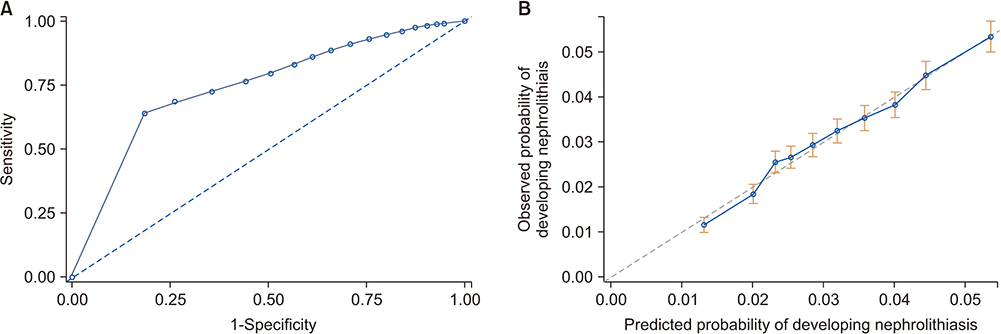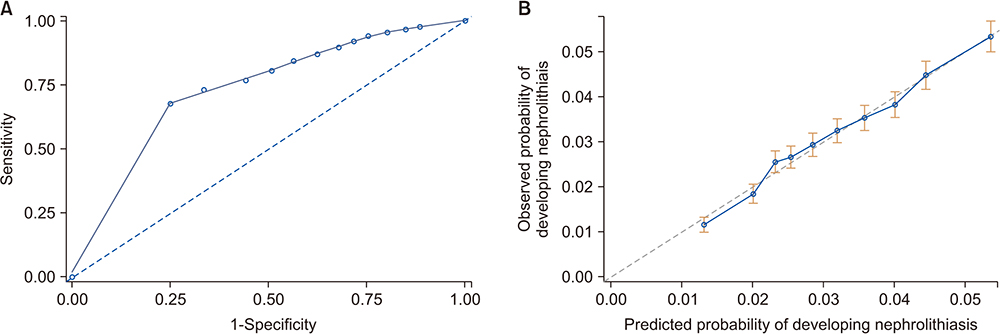Investig Clin Urol.
2020 Mar;61(2):188-199. 10.4111/icu.2020.61.2.188.
A prediction model of Nephrolithiasis Risk: A population-based cohort study in Korea
- Affiliations
-
- 1Complex Disease and Genome Epidemiology Branch, Department of Public Health, Graduate School of Public Health, Seoul National University, Seoul, Korea. jsung@snu.ac.kr
- 2Department of Epidemiology, Graduate School of Public Health and Institute of Health and Environment, Seoul National University, Seoul, Korea.
- KMID: 2471075
- DOI: http://doi.org/10.4111/icu.2020.61.2.188
Abstract
- PURPOSE
Well-validated risk prediction models help to stratify individuals on the basis of their disease risks and to guide health care professionals in decision-making. The incidence of nephrolithiasis has been increasing in Korea. Racial differences in the distribution of and risk for nephrolithiasis have been reported in Asia but no population-specific nephrolithiasis models have been developed. We aimed to develop a simplified nephrolithiasis prediction model for the Korean population by using data from general medical practice.
MATERIALS AND METHODS
This was a prospective, population-based cohort study in Korea. A total of 497,701 participants from the National Health Insurance Service-National Sample Cohort (NHIS-NSC) were enrolled from 2002 to 2010. A Cox proportional hazards model was used.
RESULTS
During a median follow-up time of 8.5 years (range, 2.0-8.9 years) and among 497,701 participants, there were 15,783 cases (3.2%) of nephrolithiasis. The parsimonious model included age, sex, income grade, alcohol consumption, body mass index, total cholesterol, fasting blood glucose, and medical history of diseases. The Harrell's C-statistic was 0.806 (95% confidence interval [CI], 0.790-0.821) and 0.805 (95% CI, 0.782-0.827) in the derivation and validation cohorts, respectively.
CONCLUSIONS
The results of the present study imply that nephrolithiasis risk can be predicted by use of data from general medical practice and based on predictors that clinicians and individuals from the general population are likely to know. This model comprises modifiable risk factors and can be used to identify those at higher risk who can modify their lifestyle to lower their risk for nephrolithiasis. This study also offers an opportunity for external validation or updating of the model through the incorporation of other risk predictors in other settings.
Keyword
MeSH Terms
Figure
Reference
-
1. Han H, Segal AM, Seifter JL, Dwyer JT. Nutritional Management of Kidney Stones (Nephrolithiasis). Clin Nutr Res. 2015; 4:137–152.
Article2. Curhan GC. Epidemiology of stone disease. Urol Clin North Am. 2007; 34:287–293.
Article3. Parmar MS. Kidney stones. BMJ. 2004; 328:1420–1424.
Article4. Curhan GC, Willett WC, Rimm EB, Speizer FE, Stampfer MJ. Body size and risk of kidney stones. J Am Soc Nephrol. 1998; 9:1645–1652.
Article5. Stapleton AE, Dziura J, Hooton TM, Cox ME, Yarova-Yarovaya Y, Chen S, et al. Recurrent urinary tract infection and urinary Escherichia coli in women ingesting cranberry juice daily: a randomized controlled trial. Mayo Clin Proc. 2012; 87:143–150.
Article6. Saigal CS, Joyce G, Timilsina AR. Urologic Diseases in America Project. Direct and indirect costs of nephrolithiasis in an employed population: opportunity for disease management? Kidney Int. 2005; 68:1808–1814.
Article7. Stamatelou KK, Francis ME, Jones CA, Nyberg LM, Curhan GC. Time trends in reported prevalence of kidney stones in the United States: 1976-1994. Kidney Int. 2003; 63:1817–1823.8. Hiatt RA, Dales LG, Friedman GD, Hunkeler EM. Frequency of urolithiasis in a prepaid medical care program. Am J Epidemiol. 1982; 115:255–265.
Article9. Romero V, Akpinar H, Assimos DG. Kidney stones: a global picture of prevalence, incidence, and associated risk factors. Rev Urol. 2010; 12:e86–e96.10. Kim Hh, Jo MK, Kwak C, Park SK, Yoo KY, Kang D, Lee C, et al. Prevalence and epidemiologic characteristics of urolithiasis in Seoul, Korea. Urology. 2002; 59:517–521.
Article11. Edvardsson VO, Indridason OS, Haraldsson G, Kjartansson O, Palsson R. Temporal trends in the incidence of kidney stone disease. Kidney Int. 2013; 83:146–152.
Article12. Scales CD Jr, Smith AC, Hanley JM, Saigal CS. Urologic Diseases in America Project. Prevalence of kidney stones in the United States. Eur Urol. 2012; 62:160–165.
Article13. Tae BS, Balpukov U, Cho SY, Jeong CW. Eleven-year cumulative incidence and estimated lifetime prevalence of urolithiasis in Korea: a national health insurance service-national sample cohort based study. J Korean Med Sci. 2018; 33:e13.
Article14. Sakhaee K, Maalouf NM, Sinnott B. Clinical review. Kidney stones 2012: pathogenesis, diagnosis, and management. J Clin Endocrinol Metab. 2012; 97:1847–1860.15. Arias Vega R, Pérula de Torres LA, Jiménez García C, Carrasco Valiente J, Requena Tapia MJ, Cano Castiñeira R, et al. Comorbidity and socio-demographic factors associated with renal lithiasis in persons aged 40 to 65: a cross-sectional study. Med Clin (Barc). 2017; 149:383–390.
Article16. Ando R, Nagaya T, Suzuki S, Takahashi H, Kawai M, Okada A, et al. Kidney stone formation is positively associated with conventional risk factors for coronary heart disease in Japanese men. J Urol. 2013; 189:1340–1346.
Article17. D'Angelo A, Calò L, Cantaro S, Giannini S. Calciotropic hormones and nephrolithiasis. Miner Electrolyte Metab. 1997; 23:269–272.18. Cury DB, Moss AC, Schor N. Nephrolithiasis in patients with inflammatory bowel disease in the community. Int J Nephrol Renovasc Dis. 2013; 6:139–142.
Article19. Nakanishi N, Tatara K, Nakamura K, Suzuki K. Risk factors for the incidence of hyperuricaemia: a 6-year longitudinal study of middle-aged Japanese men. Int J Epidemiol. 1999; 28:888–893.
Article20. Wang X, Xu X, Wu J, Zhu Y, Lin Y, Zheng X, et al. Systematic review and meta-analysis of the effect of alcohol intake on the risk of urolithiasis including dose-response relationship. Urol Int. 2015; 94:194–204.
Article21. Jeong IG, Kang T, Bang JK, Park J, Kim W, Hwang SS, et al. Association between metabolic syndrome and the presence of kidney stones in a screened population. Am J Kidney Dis. 2011; 58:383–388.
Article22. Khan SR, Pearle MS, Robertson WG, Gambaro G, Canales BK, Doizi S, et al. Kidney stones. Nat Rev Dis Primers. 2016; 2:16008.
Article23. Finlayson B. Physicochemical aspects of urolithiasis. Kidney Int. 1978; 13:344–360.
Article24. Tattevin P, Revest M, Chapplain JM, Ratajczak-Enselme M, Arvieux C, Michelet C. Increased risk of renal stones in patients treated with atazanavir. Clin Infect Dis. 2013; 56:1186.
Article25. Liu Y, Chen Y, Liao B, Luo D, Wang K, Li H, et al. Epidemiology of urolithiasis in Asia. Asian J Urol. 2018; 5:205–214.
Article26. Choi SY, Lee SY, Chi BH, Kim JW, Kim TH, Chang IH. Urbanization may affect the incidence of urolithiasis in South Korea. Springerplus. 2016; 5:1891.
Article27. Altman DG, Vergouwe Y, Royston P, Moons KG. Prognosis and prognostic research: validating a prognostic model. BMJ. 2009; 338:b605.
Article28. Collins GS, Reitsma JB, Altman DG, Moons KG. Transparent Reporting of a multivariable prediction model for Individual Prognosis or Diagnosis (TRIPOD): the TRIPOD statement. Ann Intern Med. 2015; 162:55–63.
Article29. Lee J, Lee JS, Park SH, Shin SA, Kim K. Cohort Profile: The National Health Insurance Service-National Sample Cohort (NHIS-NSC), South Korea. Int J Epidemiol. 2017; 46:e15.
Article30. Park BJ, Sung J, Park K, Seo SW, Kim SH. Studying on diagnosis accuracy for health insurance claims data in Korea. Seoul: Seoul National University;2003. p. 17–29.
- Full Text Links
- Actions
-
Cited
- CITED
-
- Close
- Share
- Similar articles
-
- Epidemiology and economics of nephrolithiasis
- Prediction of the 10-year risk of atherosclerotic cardiovascular disease in the Korean population
- Review on Cardiovascular Disease Prediction Model in Diabetes Patients
- Development and Validation of a Deep Learning Based Diabetes Prediction System Using a Nationwide Population-Based Cohort
- A prediction model of low back pain risk: a population based cohort study in Korea



